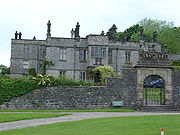
Tissington Hall
Encyclopedia

Jacobean architecture
The Jacobean style is the second phase of Renaissance architecture in England, following the Elizabethan style. It is named after King James I of England, with whose reign it is associated.-Characteristics:...
mansion house situated at Tissington
Tissington
Tissington is a village in Derbyshire, England. It is part of the estate of Tissington Hall, owned by the FitzHerbert family since 1465. It is regarded as one of the most picturesque English villages and is a popular tourist attraction, particularly during its well dressing week. It also gives its...
, near Ashbourne
Ashbourne, Derbyshire
Ashbourne is a small market town in the Derbyshire Dales, England. It has a population of 10,302.The town advertises itself as 'The Gateway to Dovedale'.- Local customs :...
. Derbyshire
Derbyshire
Derbyshire is a county in the East Midlands of England. A substantial portion of the Peak District National Park lies within Derbyshire. The northern part of Derbyshire overlaps with the Pennines, a famous chain of hills and mountains. The county contains within its boundary of approx...
. It is a Grade II* listed building.
The FitzHerberts, descended from the Norman family of Norbury Hall
Norbury Hall
Norbury Manor is a 15th century Elizabethan manor house and the adjoining 13th century stone-built medieval Norbury Hall, known as The Old Manor in Norbury near Ashbourne, Derbyshire...
, acquired Tissington by the marriage of Nicholas FitzHerbert ( the second son of John FitzHerbert of Somersal Herbert
Somersal Herbert Hall
Somersal Herbert Hall is a privately owned timber framed 16th century country house at Somersal Herbert, near Ashbourne, Derbyshire, in England...
) to Ciceley Frauncis , heiress of Tissington, in 1465.
The old moated manor at Tissington was replaced with the new mansion in 1609 by Francis FitzHerbert and remains the home of the FitzHerbert family
Fitzherbert Baronets
The FitzHerbert Baronetcy, of Tissington in the County of Derby, is a title in the Baronetage of Great Britain. It was created on 22 January 1784 for William FitzHerbert, of Tissington Hall, Derbyshire. The FitzHerberts descend from Norman knights and from the 12th century FitzHerberts of Norbury...
. Both Francis FitzHerbert and his son (Sir) John served as High Sheriff
High Sheriff
A high sheriff is, or was, a law enforcement officer in the United Kingdom, Canada and the United States.In England and Wales, the office is unpaid and partly ceremonial, appointed by the Crown through a warrant from the Privy Council. In Cornwall, the High Sheriff is appointed by the Duke of...
of Derbyshire, a post that circulated among the county families.
It is the hall that makes Tissington Hall unusual. It is one of a small group of compact Derbyshire gentry houses in which a central hall runs through the house from front to back. Nicholas Cooper surmises that the unusual, progressive character may be due to the influence of lodges (he counted some fifty emparked estates in Saxton's map of the shire, of 1570) and the grand example of a through-hall at Hardwick
Hardwick Hall
Hardwick Hall , in Derbyshire, is one of the most significant Elizabethan country houses in England. In common with its architect Robert Smythson's other works at both Longleat House and Wollaton Hall, Hardwick Hall is one of the earliest examples of the English interpretation of the Renaissance...
. Behind a two-storey enclosed entrance porch (illustration, right), the hall is entered at the center of one end. On the left are two parlors separated by a stairhall, on the right a kitchen and buttery
Buttery
Buttery may refer to:* Buttery , a savoury Scottish bread roll* Buttery , a storeroom for liquor*Buttery A service room in a large medieval household.* Buttery, a cafe that sells food and drinksPeople named Buttery:...
. Corner towers on the garden front, now linked by the additional upper floor above the gallery range, provide further rooms.
A rococo gothick fireplace in the house follows a published design by Batty Langley
Batty Langley
Batty Langley was an English garden designer, and prolific writer who produced a number of engraved designs for "Gothick" structures, summerhouses and garden seats in the years before the mid-18th century.The eccentric landscape designer, who gave some of his numerous children names like Hiram,...
.

The Hall is open to the public at specified times of the year and is available for commercial and private functions.

